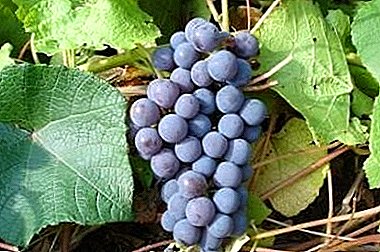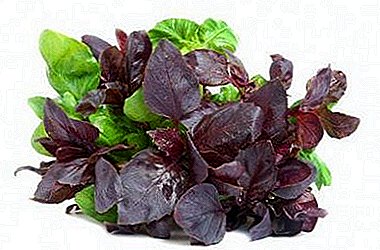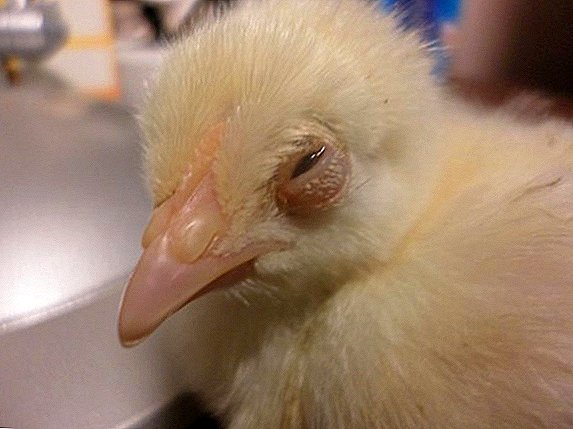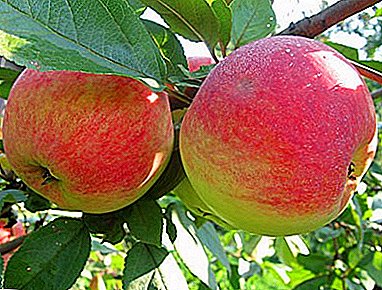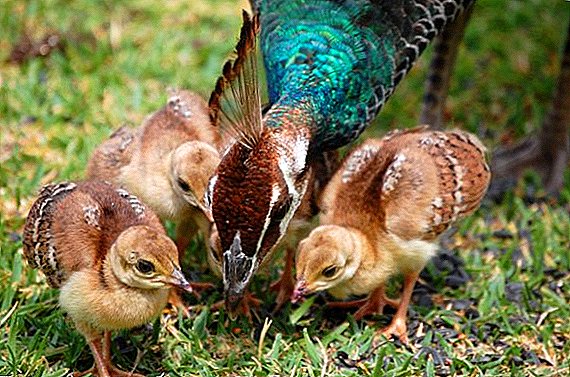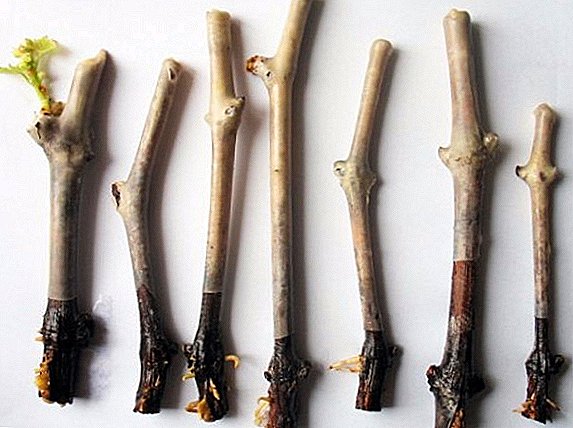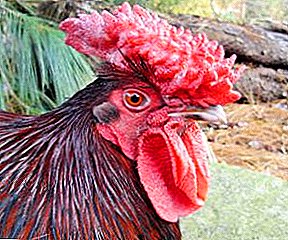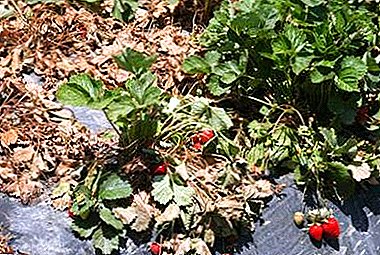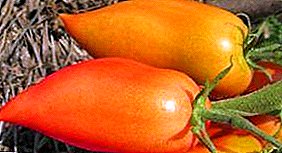
Delicious, starchy and almost juice-free tomatoes, which are striking in their size and shape, are all about the new variety from Siberian breeders, called “Uncle Stepa”.
As a fabulous kind giant known to all from childhood, at first sight they attract all the attention to themselves.
And to learn more about what this variety is, you can read in our article. And also get acquainted with the full description of the variety, its characteristics and characteristics of cultivation.
Tomato "Uncle Stepa": description of the variety
| Grade name | Uncle Styopa |
| general description | Mid-season indeterminantny grade |
| Originator | Russia |
| Ripening | 110-115 days |
| The form | Elongated, with oval cross-section and slightly pointed tip |
| Colour | Red |
| Average tomato mass | 180-300 grams |
| Application | Culinary processing and harvesting |
| Yield varieties | 8 kg from a bush |
| Features of growing | Yield is highly dependent on good watering. |
| Disease resistance | Need prevention of late blight |
 Grade "Uncle Styopa" fully justifies its name due to unlimited growth - the bushes of this tomato are indeterminate, that is, they can grow throughout the summer.
Grade "Uncle Styopa" fully justifies its name due to unlimited growth - the bushes of this tomato are indeterminate, that is, they can grow throughout the summer.
Plant height varies depending on growing conditions from 1.5 to 2.5 meters. The leafiness is average, the number of stepsons is relatively high, therefore, the variety needs constant care in the form of pinching. Also, tomatoes require regular fertilizer. The ripening period of the fruit falls on 110-115 days after sowing seeds for seedlings, there way, the variety "Uncle Stepa" refers to the medium. Tomatoes have average disease resistance characteristics.
Suitable for cultivation in open and protected ground. The fruits of the tomato "Uncle Stepa" are distinguished by their unusually large size and the shape that is not typical for tomatoes. Most of all they resemble bananas: elongated, with an oval cross-section and a slightly pointed tip. The length of individual tomatoes reaches 20 cm, and the average weight is 180 g. When creating optimal conditions for growth, fruits can grow up to 300 g.
The amount of dry and starchy substances is high, there is practically no free liquid in fruits. Seed chambers are not many - from 3 to 5 in the fruit. The skin is dense and thin, in a state of ripeness is colored in a rich red color. Fruits tolerate transportation and can be kept fresh for up to 75 days. When stored in the refrigerator, this period is extended to 90 days.
Compare the weight of fruit varieties with others can be in the table:
| Grade name | Fruit weight |
| Uncle Styopa | 180-300 grams |
| Tarasenko Yubileiny | 80-100 grams |
| Rio grande | 100-115 grams |
| Honey | 350-500 grams |
| Orange Russian 117 | 280 grams |
| Tamara | 300-600 grams |
| Wild Rose | 300-350 grams |
| Honey King | 300-450 grams |
| Apple Spas | 130-150 grams |
| Thick cheeks | 160-210 grams |
| Honey Drop | 10-30 grams |
Specifications
Tomatoes varieties "Uncle Stepa" created by Russian breeders in 2008. It was introduced to the State Register of Seeds in 2012. The variety is suitable for growing in conditions with an unstable climate. Good yields in the middle lane, Black Earth, in Siberia and the Far East. Not bad variety has proven itself in the southern regions of Russia.
Tomatoes "Uncle Stepa" are intended for cooking and blanks - pickles and pickles. It makes excellent tomato pastes, but it is not suitable for the production of juices. The yield of one plant reaches 8 kg.
The variety is well resistant to short-term low temperatures and responds well to the introduction of organic matter. The abundance of large brushes on one plant allows you to get good yields while saving space. Among the shortcomings of the variety, we can mention the need for weekly staving and the constant garter of the bush for trellis.
You can compare the yield of a variety with others in the table below:
| Grade name | Yield |
| Uncle Styopa | 8 kg from a bush |
| Malachite Box | 4 kg per square meter |
| Tamara | 5.5 kg from a bush |
| Inseparable Hearts | 14-16 kg per square meter |
| Perseus | 6-8 kg per square meter |
| Giant Raspberry | 10 kg from a bush |
| Russian Happiness | 9 kg per square meter |
| Crimson sunset | 14-18 kg per square meter |
| Thick cheeks | 5 kg from a bush |
| Doll Masha | 8 kg per square meter |
| Garlic | 7-8 kg from a bush |
| Palenka | 18-21 kg per square meter |
Features of growing
 In the absence of sufficient moisture, the fruits of the Uncle Stepa tomato become small and hollow inside. At the same time, with an excess of soil moisture, tomatoes are not prone to cracking.
In the absence of sufficient moisture, the fruits of the Uncle Stepa tomato become small and hollow inside. At the same time, with an excess of soil moisture, tomatoes are not prone to cracking.
The variety needs high soil nutrients.. He responds well to the introduction of mineral and organic supplements, which are recommended at least once every 10 days. To obtain the optimal amount of commercial fruits, it is recommended to plant no more than 5 plants per square meter.
It is better to form a bush in 2 stalks. Shortts below 4-5 leaves are removed completely. As the fruit is poured, the leaves below them are also removed.
 Read on our site all about the diseases of tomatoes in greenhouses and how to combat these diseases.
Read on our site all about the diseases of tomatoes in greenhouses and how to combat these diseases.We also offer materials on high-yielding and disease-resistant varieties.
Diseases and pests
When grown in greenhouses, tomatoes are damaged by the whitefly. To combat it, you should regularly hang sticky traps in the greenhouse. When a large number of pests are recommended to treat plants with insecticides permitted for use in enclosed spaces.
Of the diseases of this variety of tomatoes threatens only phytophthora and various forms of spots. Since these diseases are of a mushroom nature, it is recommended to fight them with drugs Hom and other means with copper, as well as fungicides.
"Uncle Styopa" - a very unusual tomato with excellent taste. Its cultivation, of course, is associated with some expenditure of effort, but the yield may surprise even experienced gardeners.
| Late-ripening | Early maturing | Middle late |
| Bobcat | Black bunch | Golden Crimson Miracle |
| Russian size | Sweet bunch | Abakansky pink |
| King of Kings | Kostroma | French grapevine |
| Long keeper | Buyan | Yellow banana |
| Grandma's Gift | Red bunch | Titanium |
| Podsinskoe miracle | The president | Slot |
| American ribbed | Summer resident | Krasnobay |



